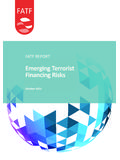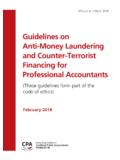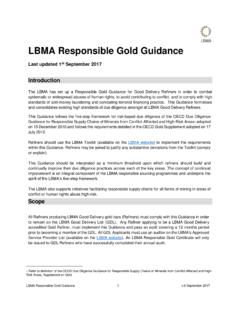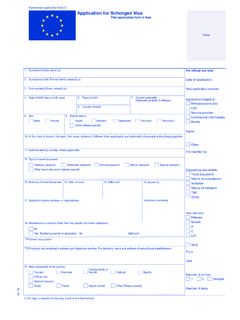Transcription of MEASURING AND UNDERSTANDING THE IMPACT OF …
1 MEASURING AND UNDERSTANDING THE IMPACT OF TERRORISMSPECIAL THANKS to the National Consortium for the Study of terrorism and Responses to terrorism (START), a Department of Homeland Security Center of Excellence led by the University of Maryland, for their cooperation on this study and for providing the Institute for Economics and Peace with their global terrorism Database (GTD) datasets on CENTER OF EXCELLENCEOF THE DEPARTMENT OF HOMELAND SECURITYLED BY THE UNIVERSITY OF MARYLANDQ uantifying Peace and its BenefitsThe Institute for Economics and Peace (IEP) is an independent, non-partisan, non-profit think tank dedicated to shifting the world s focus to peace as a positive, achievable, and tangible measure of human well-being and achieves its goals by developing new conceptual frameworks to define peacefulness; providing metrics for MEASURING peace; and uncovering the relationships between business, peace and prosperity as well as promoting a better UNDERSTANDING of the cultural, economic and political factors that create has offices in Sydney, New York, Brussels and Mexico City.
2 It works with a wide range of partners internationally and collaborates with intergovernmental organizations on MEASURING and communicating the economic value of more information visit SUMMARY 2 ABOUT THE global terrorism index 6 RESULTS 9 global terrorism index map 10 Terrorist incidents map 12 terrorism in 2015 14 Ten countries most IMPACT by terrorism 25 TRENDS 35 Trends in terrorism 2000-2015 36 Trends in OECD countries 40 TERRORIST GROUPS 49 terrorism and ongoing conflict 51 The four deadliest terrorist groups 52 Connections between groups 58 ECONOMIC IMPACT OF terrorism 61 Economic IMPACT of terrorism in 2015 62 Peacebuilding, terrorism and violent conflict 65 CORRELATES & DRIVERS OF terrorism 69 The link between political terror, human rights and terrorism 72 Statistical properties of terrorist organisations 74 EXPERT CONTRIBUTIONS 77 Victoria Police Counter terrorism Command s Specialist Intelligence Team Community driven prevention: The Victorian security environment 77 Dr Khalid Koser and Amy E.
3 Cunningham, global Community Engagement and Resilience Fund Why Preventing Violent Extremism is the private sector s business 79 Dr Paolo Maggiolini and Dr Arturo Varvelli, Institute for International Political Studies Jihadist hotbeds and local radicalization processes 81 Dr Christina Schori Liang, Geneva Centre for Security Policy Mapping the new global criminal-terrorist networks 84 Sebastian von Einsiedel, United Nations University Centre for Policy Research Assessing the UN s efforts to counter terrorism 88 APPENDICES 93 Appendix A: GTI ranks and scores, 2016 94 Appendix B: 50 worst terrorist attacks in 2015 96 Appendix C: global terrorism index methodology 98 ENDNOTES 101 CONTENTS1 3 2 456 The research presented in this report highlights a complex and rapidly changing set of dynamics in global terrorism .
4 While on the one hand the top-line statistics highlight an improvement in the levels of global terrorism , the continued intensification of terrorism in some countries is a cause for serious concern, and highlights the fluid nature of modern terrorist activity. The complexity of this year s GTI is underscored by the fact that although 76 countries improved their GTI scores compared to 53 countries that worsened, the overall global GTI score deteriorated by six per cent since last year as many moderately affected countries experienced record levels of terrorism . The 2016 GTI finds there has been a change from the pattern of the previous four years. 2015 saw the total number of deaths decrease by ten per cent, the first decline since 2010.
5 The number of countries recording a death from terrorism also decreased by one. This decline in terrorism deaths is mainly attributed to a weakened Boko Haram and ISIL in both Nigeria and Iraq due to the military operations against them. However, expanded activities by both of these groups in other countries is posing new threats in other parts of the world. Boko Haram has expanded into Niger, Cameroon and Chad, increasing the number of people they have killed through terrorism in these three countries by 157 per cent. Meanwhile ISIL and its affiliates were active in 15 new countries, bringing the total number of countries they were active in to 28. This is largely why a record number of countries recorded their highest levels of terrorism in any year in the past 16 years.
6 There was a ten per cent decline from 2014 in the number of terrorism deaths in 2015 resulting in 3,389 fewer people This is the fourth edition of the global terrorism index which provides a comprehensive summary of the key global trends and patterns in terrorism over the last 16 years, covering the period from the beginning of 2000 to the end of by the Institute for Economics and Peace, the GTI is based on data from the global terrorism Database which is collected and collated by the National Consortium for the Study of terrorism and Responses to terrorism (START), a Department of Homeland Security Centre of Excellence led by the University of Maryland.
7 The global terrorism Database is considered to be the most comprehensive dataset on terrorist activity globally and has now codified over 150,000 terrorist incidents. being killed. Iraq and Nigeria together recorded 5,556 fewer deaths and 1,030 fewer attacks than in 2014. However, with a global total of 29,376 deaths, 2015 was still the second deadliest year on record. While the weakening of ISIL and Boko Haram in their central areas of operations in Iraq and Nigeria is positive, this change has coincided with two key negative trends which have driven up terrorism in the rest of the world. The first is ISIL s shift in tactics to transnational terrorism , not just to other parts of the Middle East but to Europe as well.
8 The second key negative trend is Boko Haram s extension into neighbouring West African countries which has led to Cameroon and Niger rising to 13th and 16th in the GTI. Accompanied with these two key negative trends was an increase in the number of ISIL-affiliated groups that undertook attacks. The research found that the number of countries with greater than 25 deaths rose to 34, an increase of seven to the highest numbers ever recorded. At least six countries saw very significant deteriorations in their GTI scores in 2015 leading to large rank changes from the previous year. This accounted for the overall deterioration in the global GTI score of six per cent as these falls outweighed the substantial gains in Nigeria and Iraq.
9 These countries include; France, Turkey, Saudi Arabia, Kuwait, Tunisia and Burundi. In Europe, ISIL s transnational tactics in combination with lone actor attacks inspired by the group drove an increase in terrorism to its highest levels ever. This increase was seen in many OECD countries resulting in a 650 per cent increase in EXECUTIVE SUMMARY2 global terrorism index 2016 | Executive Summarydeaths to 577 from 77 in 2014. ISIL s role in this increase was significant as more than half of the 577 deaths were in connection to the group. The attacks by ISIL in Paris, Brussels and in Turkey s capital Ankara, were amongst the most devastating in the history of these countries and reflect a disturbing return of the transnational group-based terrorism more associated with al-Qa ida before and immediately after September 11.
10 It is important to note that while the international community s focus has intensified on ISIL and its activities in Iraq and Syria, last year recorded the deadliest year for the Taliban in Afghanistan. Both terrorist deaths and battlefield deaths committed by the Taliban significantly increased in 2015. terrorism increased 29 per cent to 4,502 deaths and battlefield deaths increased 34 per cent to over 15, complex global picture was rounded out by pockets of more positive news whereby many other countries saw improvements in their levels of terrorist activity. One less country recorded a terrorist attack in 2015 than 2014, which halted the prior four-year trend of yearly increases in the number of countries experiencing terrorist activity.








